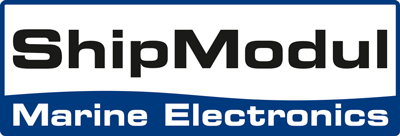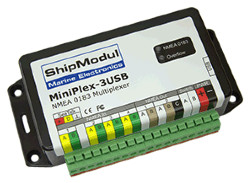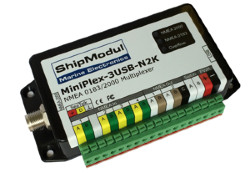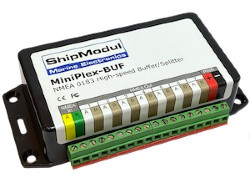
ShipModul
ShipModul provides advanced solutions for the reliable communication of NMEA data between multiple talkers and listeners. They are offering several interfacing options (NMEA0183, N2K, USB, Ethernet, Wi-Fi …) a rich set of features and configurations while eliminating ground loops. This makes the outputs compatible with all sorts of inputs, whether they are isolated or not, differential (RS-422) or grounded (RS-232).
The MiniPlex series multiplexers are the ultimate solution to connect old and new worlds and the perfect gateway to computers and tablets.
The MiniPlex-BUF NMEA buffer/splitter is designed to solve the problem of sharing NMEA data from one NMEA device with multiple other NMEA devices in a trouble-free manner.
Moreover, their wide-ranging (8-35VDC) power supply is secured against reverse polarity. So, regardless of your system’s interfacing requirements and complexity stable performing reliable communication is ensured.

The MiniPlex-3 Series NMEA multiplexers comprise a range of advanced NMEA multiplexers which combine data from multiple navigation instruments. Through an advanced filtering and routing system, this data can be sent to other navigation instruments and to computers, tablets, and smartphones.
A bi-directional SeaTalk1 interface enables conversion between SeaTalk1 data and NMEA 0183 sentences. This conversion works both ways, allowing the MiniPlex-3 to replace Raymarine’s SeaTalk-NMEA bridge (E85001).
MiniPlex-3 models with an NMEA 2000 interface (-N2K suffix) connect directly to an NMEA 2000 backbone and convert between NMEA 2000 PGN’s, NMEA 0183 sentences, and SeaTalk1 datagrams in all directions.
The MiniPlex-3PRO has the same functionality as the MiniPlex-3E-N2K, but it allows for up to 8 inputs and up to 4 outputs into one box.
All data is available on one or more computer interfaces in NMEA 0183 format. NMEA 2000 PGN’s and SeaTalk datagrams for which no NMEA 0183 equivalent exists, can be converted to special NMEA 0183 sentences, allowing software developers to support processing of raw NMEA 2000 and SeaTalk data.
Each and every port on a MiniPlex-3 multiplexer is galvanically isolated from the internal electronics and from every other port. This guarantees that no ground loops will be created when adding a MiniPlex-3 to a navigation network. It also ensures a trouble-free connection to any type of NMEA 0183 port of any device.
The MiniPlex-3 multiplexers are all functionally identical but differ in type and number of computer interfaces.
The MiniPlex-BUF is an advanced NMEA buffer/splitter featuring one input and seven outputs. It is designed to solve the problem of sharing NMEA data from one NMEA device with multiple other NMEA devices in a trouble-free manner.
The received NMEA signal is amplified to the proper NMEA levels, ensuring delivery of an NMEA signal to connected devices which meets or exceeds the specifications of the NMEA standard.
Fully isolated inputs and outputs eliminate all ground loops. The outputs are short circuit proof, ensuring delivery of NMEA data to all connected devices in a reliable manner, independent of short circuits on one or more outputs.
Technical features
Commonly available buffers usually offer multiple outputs from a common – isolated – power supply. The outputs are isolated from the ship’s power supply, but they are still connected to each other.
The MiniPlex-BUF offers full isolation on all outputs because each output has its own isolated power supply. This makes the outputs compatible with all sorts of inputs, whether they are isolated or not, differential (RS-422) or grounded (RS-232).
NMEA Input
The NMEA input is a galvanically isolated input, using a high-speed opto-coupler capable of transporting data up to 230.400 Baud. The input is fully compatible with the NMEA specification. This allows the input to work in a noisy environment and with long cable runs. The isolated input removes any ground loops that might exist between the connected device and the buffer. It also withstands any ground or common-mode potential up to 1500V.
NMEA Outputs
The MiniPlex-BUF is equipped with 7 fully isolated outputs, each with its own opto-coupler and isolated power supply. This technology creates completely floating outputs that make a connection to any device an easy task. Each output automatically adjusts to the type of input it is connected to, whether this is an isolated, differential, or single-ended input. Connection to a grounded RS-232 input on a computer is no problem and does not influence other outputs.
Isolation
The MiniPlex-BUF offers three barriers against ground loops. The first barrier is on the isolated input, the second barrier is on each of the isolated outputs and the third barrier is on each of the isolated DC/DC converters used to power each output.
Defect proof
A major benefit of completely isolated outputs is that a short circuit on one output has no influence on the signal of the other outputs. Signal delivery to connected devices is therefore guaranteed to the highest possible level.
All these features make the MiniPlex-BUF one of the safest and easiest buffers to install.
CONTACT FOR PRICES
-
Fully isolated IN/OUT
-
NMEA routing & filtering
-
NMEA0183 & N2K
-
Flexible communication speed
-
Data conversion
-
Priority
-
Channel info
-
Talker ID substitution






























